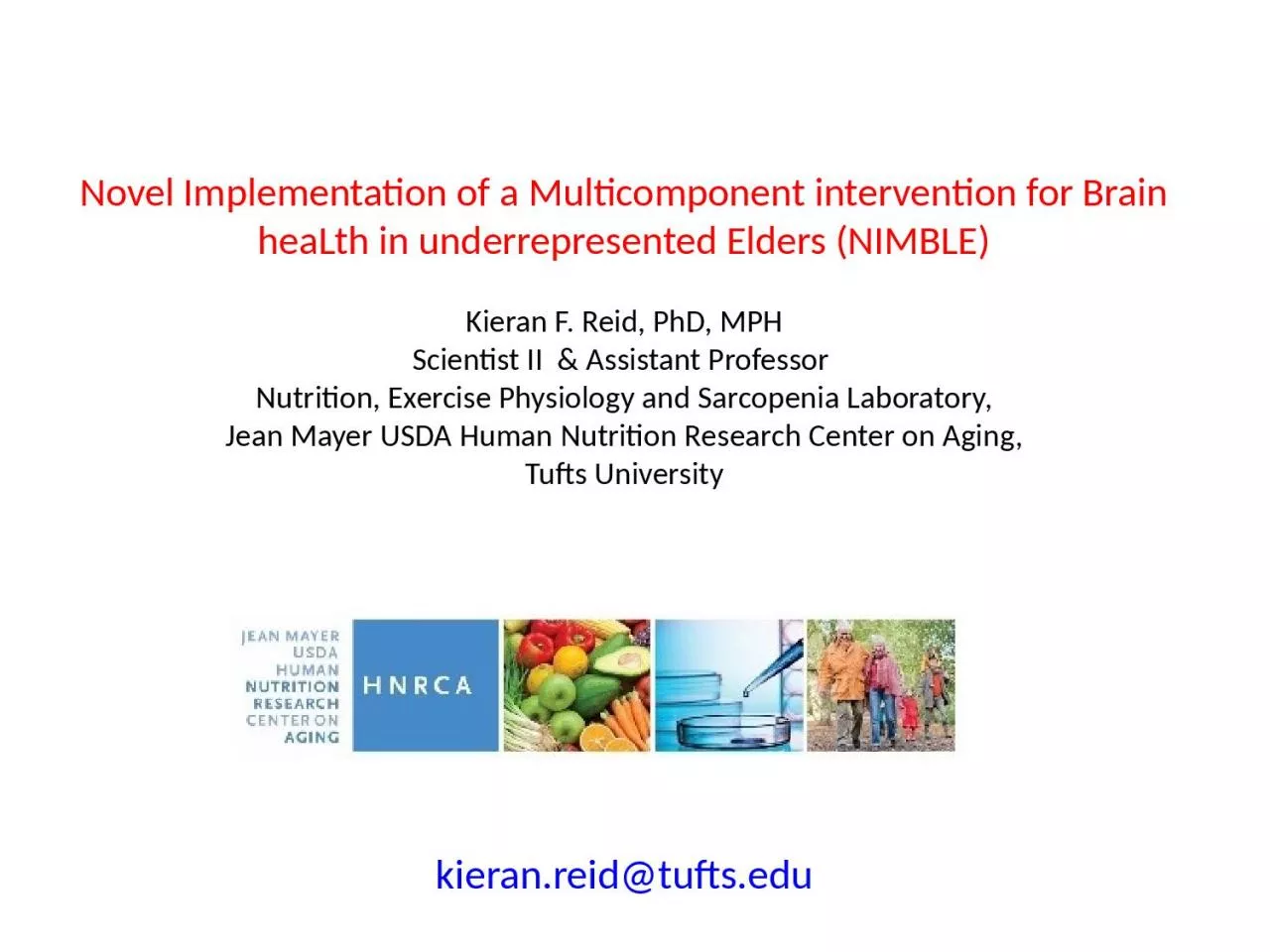

heaLth in underrepresented Elders NIMBLE Kieran F Reid PhD MPH Scientist II amp Assistant Professor Nutrition Exercise Physiology and Sarcopenia Laboratory Jean Mayer USDA Human Nutrition Research Center on Aging ID: 1033824
Download Presentation The PPT/PDF document "Novel Implementation of a Multicomponent..." is the property of its rightful owner. Permission is granted to download and print the materials on this web site for personal, non-commercial use only, and to display it on your personal computer provided you do not modify the materials and that you retain all copyright notices contained in the materials. By downloading content from our website, you accept the terms of this agreement.
1. Novel Implementation of a Multicomponent intervention for Brain heaLth in underrepresented Elders (NIMBLE)Kieran F. Reid, PhD, MPHScientist II & Assistant Professor Nutrition, Exercise Physiology and Sarcopenia Laboratory,Jean Mayer USDA Human Nutrition Research Center on Aging,Tufts University kieran.reid@tufts.edu
2. BackgroundAge-related cognitive decline has a profound impact on the daily functioning of older adults, their families and healthcare systems. Currently over 6 million US older adults are living with Alzheimer’s disease or a related dementia (ADRD). This number will double by 2030 and more than triple by 2050. These estimates are pre-COVID-19 with most reliable models suggesting that the pandemic: Will be a protracted process requiring ongoing mitigation measuresImpact of social interaction and environmental stimulation maybe be detrimental to brain aging?Accelerated behavioral-cognitive decline resulting in more progression and conversion to dementia in at-risk older adults?Regardless of the duration of COVID-19, and in the absence of a pharmacologic treatment for ADRD, the current situation provides sufficient basis to rethink and restrategize as to how we can develop interventions to mitigate ADRD.
3. Preventive Interventions – target the risk factors “Guidelines on risk reduction of cognitive decline and dementia”May, 2019“Four in 10 dementia cases could be prevented or delayed by targeting risk factors”August, 2020
4. e.g. ……………Physical Activity ENGAGE Study (ENhancing independence using Group-based community interventions for healthy AGing in Elders) Physical activity intervention translated to a real-world community-based senior center in Greater Boston Areasafe & feasible ↑ executive cognitive functioning, preserves mobility, ↓ falls, ↑ quality of life ENGAGE Participants – Baseline CharacteristicsDigit Symbol Substitution Test Score ENGAGE PA Improves Cognition Reid et al. 2018 J Gerontol A Biol Med Sci
5. e.g. ……………NutritionMIND diet
6. Potential Benefits of Multicomponent InterventionsADRD is complex and multifactorialTargeting several risk factors and mechanisms simultaneously may be necessary to optimize preventative effects A Landmark Study:FINGER: Finnish Geriatric Intervention Study to Prevent Cognitive Impairment and Disability (Lancet 2015)
7. Screening1st Baseline visít2nd Baseline visitRANDOMIZATIONINTENSIVE INTERVENTIONREGULAR HEALTH ADVICEINTERVENTION KICK-OFFMINI-INTERVENTION3691215182124NUTRITION: 10-20% daily energy from proteins, 25-35% from fat, 45-55% from carbohydrates25-35g/day of fiber, < 5g/day of salt, <5% daily energy from alcohol COGNITIVE TRAINING:9 group sessions Independent trainingEXERCISE:1-2x/wk muscle2-4x/wk aerobicEXERCISE:2x/wk muscle4-5x/vk aerobicEXERCISE:2x/wk muscle strength training5x/wk aerobic trainingMONITORING AND MANAGEMENT OF METABOLIC AND VASCULAR RISK FACTORSNurse: Visit every 3 months, Physician: 3 additional visits monthsINTERVENTION SCHEDULECOGNITIVE TRAINING:2 group sessiosIndependent training
8. Improved Cognition
9. Rationale for NIMBLEDevelop a remote /home based multicomponent intervention to reach underserved older adults at risk for cognitive declineMost studies are intensive, center/clinic based, face-to-face, intensive interventions Initially try to reach African American/Black and Latinx older adults in Greater BostonADRD incidence rates x 2 in African American/Black older adults, x 1.5 in Latino older adult populations Develop study in 2 phases: In Phase I, our overarching objective will be to develop, test and refine NIMBLE to demonstrate its initial feasibility.In Phase II, our overarching objective is to examine the effects of NIMBLE on cognitive performance and known ADRD lifestyle-related risk factors. Identify “at-risk” older adults
10. Rationale for NIMBLEMotoric Cognitive Risk Syndrome (MCR): Verghese et al. 2013 - subjective cognitive (memory) complaints and slow walking speed - assessment is simple as it avoids the need for clinical / neuropsychological testing - it has been shown to be an early & independent predictor of future cognitive decline and dementia in older adults ………”can identify older persons who have over a three-fold greater risk of developing dementia” …….. (Verghese et al. 2013, 2016; Allali et al. 2016) - MCR may represent a distinct “at-risk” target population that may benefit from NIMBLE
11. NIMBLE Intervention – Phase 1Participants will be supplied with an Ipad and a 4 month cellular / unlimited data plan. A BrainBaseline app/portal will be developed and utilized for the cognitive assessments and also to facilitate the delivery of the various components of the NIMBLE intervention We anticipate that approximately 30% of enrolled participants will be Spanish speaking (n = 10)
12. NIMBLE Intervention – Phase 2Participants will be supplied with an Ipad and a 12 month cellular / unlimited data plan. A BrainBaseline app/portal will be developed and utilized for the cognitive assessments and also to facilitate the delivery of the various components of the NIMBLE intervention We anticipate that approximately 30% of enrolled participants will be Spanish speaking (n = 10)
13. Study Inclusion /Exclusion Criteria Participants will be considered to have MCR if they meet all of the following criteria: Self-reported memory complaint as assessed by Question 10 on the GDS (“Do you feel you have more problems with memory than most?”). Objectively defined slow gait (< 0.80 m/sec). Absence of mobility-disability (inability to ambulate even with assistance or walking aids) Absence of dementia diagnosis.
14. Research Timeline
15. Novel Implementation of a Multicomponent intervention for Brain heaLth in underrepresented Elders (NIMBLE)kieran.reid@tufts.eduFunding applications (Tufts, NIH) in September, October and FebruaryEmail of Interest?